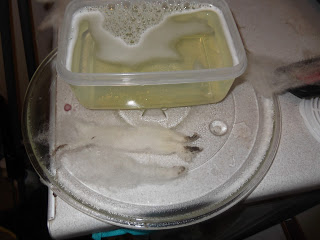I need a hook
But I have got ahead of myself.
Where was I? Oh yes.
So.
having been emboldened by my increasing mastery of the spindle (by increasing mastery, I mean that my spun yarn is becoming less like an anchor chain and more like a thread, and is marginally more regular so long as I don't get too carried away trying to spin like on the youtube videos,) I decided to get ambitious.
The cheapest way to buy wool is to buy an unprocessed fleece.
Oh yes!
Then you wash it, separate out the 'bats' and card it.
Hokay!
So I ordered a fleece off ebay and a few days later it arrived, a shaggy brown, grass tipped smelly mass of fur.
Looked online about washing it. I am NOT risking my washing machine's filter and I certainly don't want to felt this thing by accident so in the bucket it goes with plain cold water. A little swishing but only a little, let it stand a while, pour out water, and then repeat. I don't want to wash out too much of the lanolin so not using detergent at this point.
Sorry, no photos of the washing because I didn't think to take any. However I have one of the dried fleece hanging on an airer.
Let me say at this point that if you are considering trying this, do NOT leave it to dry anywhere you actually spend any time or have to visit regularly. the bathroom, living room, bedroom, kitchen are all bad places to leave a fleece to dry.
Why?
Because it smells, that's why.
OK the smell isn't actually foul as such, but it is pungent, strong, and definitely barnyard.
Now, according to the videos etc, you now have a nice mass of wool that can be easily separated into bats.
errr right! I have a stretchy sagging mass of stretchy sagging stuff.
Bats? Seems to be a term for 'sheep dreadlock'.
How to identify a bat.
Find one of the dirty grassy tips which didn't wash off and tug at it. It should be a sort of finger of (hopefully not too matted) fur with the dirty tip at one end (which you are holding) and the cut ends where the sheep was shorn at the other.
to be continued



































